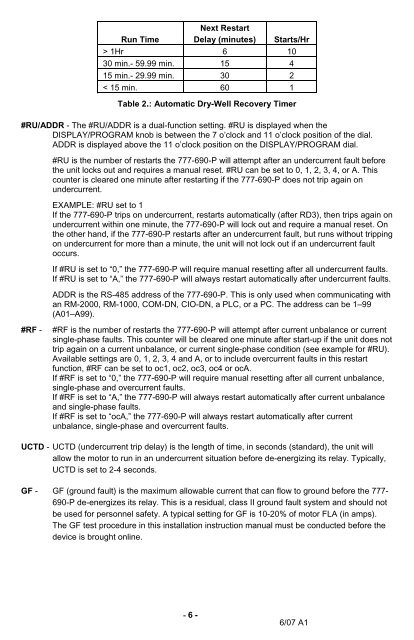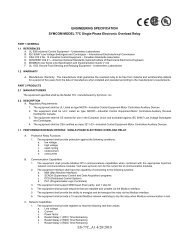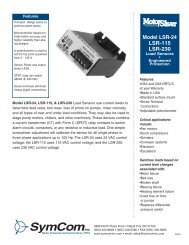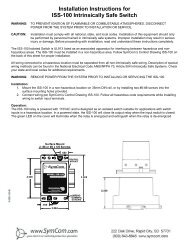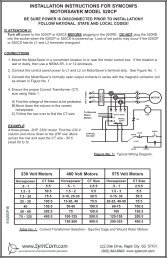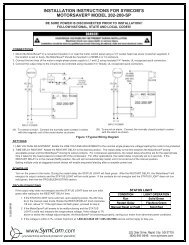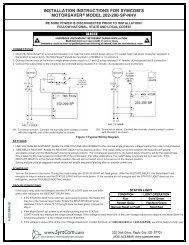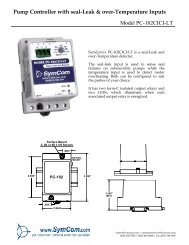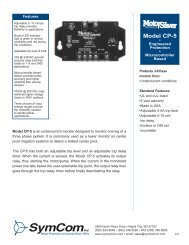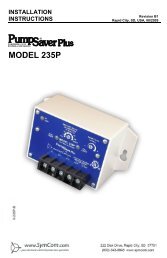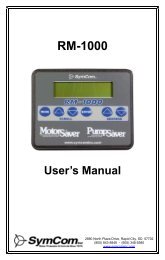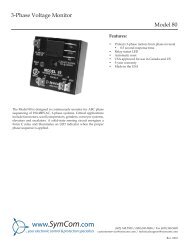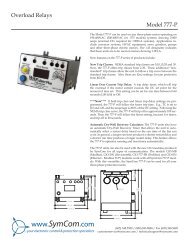installation instructions for the model 777-690-p - SymCom
installation instructions for the model 777-690-p - SymCom
installation instructions for the model 777-690-p - SymCom
Create successful ePaper yourself
Turn your PDF publications into a flip-book with our unique Google optimized e-Paper software.
Run Time<br />
Next Restart<br />
Delay (minutes) Starts/Hr<br />
> 1Hr 6 10<br />
30 min.- 59.99 min. 15 4<br />
15 min.- 29.99 min. 30 2<br />
< 15 min. 60 1<br />
Table 2.: Automatic Dry-Well Recovery Timer<br />
#RU/ADDR - The #RU/ADDR is a dual-function setting. #RU is displayed when <strong>the</strong><br />
DISPLAY/PROGRAM knob is between <strong>the</strong> 7 o’clock and 11 o’clock position of <strong>the</strong> dial.<br />
ADDR is displayed above <strong>the</strong> 11 o’clock position on <strong>the</strong> DISPLAY/PROGRAM dial.<br />
#RU is <strong>the</strong> number of restarts <strong>the</strong> <strong>777</strong>-<strong>690</strong>-P will attempt after an undercurrent fault be<strong>for</strong>e<br />
<strong>the</strong> unit locks out and requires a manual reset. #RU can be set to 0, 1, 2, 3, 4, or A. This<br />
counter is cleared one minute after restarting if <strong>the</strong> <strong>777</strong>-<strong>690</strong>-P does not trip again on<br />
undercurrent.<br />
EXAMPLE: #RU set to 1<br />
If <strong>the</strong> <strong>777</strong>-<strong>690</strong>-P trips on undercurrent, restarts automatically (after RD3), <strong>the</strong>n trips again on<br />
undercurrent within one minute, <strong>the</strong> <strong>777</strong>-<strong>690</strong>-P will lock out and require a manual reset. On<br />
<strong>the</strong> o<strong>the</strong>r hand, if <strong>the</strong> <strong>777</strong>-<strong>690</strong>-P restarts after an undercurrent fault, but runs without tripping<br />
on undercurrent <strong>for</strong> more than a minute, <strong>the</strong> unit will not lock out if an undercurrent fault<br />
occurs.<br />
If #RU is set to “0,” <strong>the</strong> <strong>777</strong>-<strong>690</strong>-P will require manual resetting after all undercurrent faults.<br />
If #RU is set to “A,” <strong>the</strong> <strong>777</strong>-<strong>690</strong>-P will always restart automatically after undercurrent faults.<br />
ADDR is <strong>the</strong> RS-485 address of <strong>the</strong> <strong>777</strong>-<strong>690</strong>-P. This is only used when communicating with<br />
an RM-2000, RM-1000, COM-DN, CIO-DN, a PLC, or a PC. The address can be 1–99<br />
(A01–A99).<br />
#RF -<br />
#RF is <strong>the</strong> number of restarts <strong>the</strong> <strong>777</strong>-<strong>690</strong>-P will attempt after current unbalance or current<br />
single-phase faults. This counter will be cleared one minute after start-up if <strong>the</strong> unit does not<br />
trip again on a current unbalance, or current single-phase condition (see example <strong>for</strong> #RU).<br />
Available settings are 0, 1, 2, 3, 4 and A, or to include overcurrent faults in this restart<br />
function, #RF can be set to oc1, oc2, oc3, oc4 or ocA.<br />
If #RF is set to “0,” <strong>the</strong> <strong>777</strong>-<strong>690</strong>-P will require manual resetting after all current unbalance,<br />
single-phase and overcurrent faults.<br />
If #RF is set to “A,” <strong>the</strong> <strong>777</strong>-<strong>690</strong>-P will always restart automatically after current unbalance<br />
and single-phase faults.<br />
If #RF is set to “ocA,” <strong>the</strong> <strong>777</strong>-<strong>690</strong>-P will always restart automatically after current<br />
unbalance, single-phase and overcurrent faults.<br />
UCTD - UCTD (undercurrent trip delay) is <strong>the</strong> length of time, in seconds (standard), <strong>the</strong> unit will<br />
allow <strong>the</strong> motor to run in an undercurrent situation be<strong>for</strong>e de-energizing its relay. Typically,<br />
UCTD is set to 2-4 seconds.<br />
GF - GF (ground fault) is <strong>the</strong> maximum allowable current that can flow to ground be<strong>for</strong>e <strong>the</strong> <strong>777</strong>-<br />
<strong>690</strong>-P de-energizes its relay. This is a residual, class II ground fault system and should not<br />
be used <strong>for</strong> personnel safety. A typical setting <strong>for</strong> GF is 10-20% of motor FLA (in amps).<br />
The GF test procedure in this <strong>installation</strong> instruction manual must be conducted be<strong>for</strong>e <strong>the</strong><br />
device is brought online.<br />
- 6 -<br />
6/07 A1


